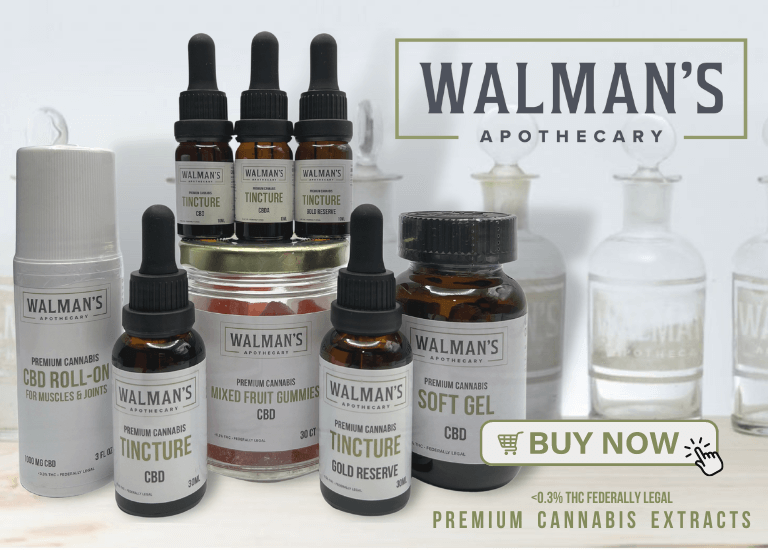Why use CBD oil topically instead of taking a bite out of a yummy gummy bear? What’s the advantage to using topical CBD versus using it sublingually (under the tongue)? Why rub CBD oil into your skin instead of taking a CBD capsule?
There are many ways to use CBD. But for a few conditions, applying it topically seems to work best.
Rubbing CBD oil into your skin, many experts believe, is best suited to mitigate muscle stiffness, joint pain and chronic inflammation.
How Does Topical CBD Work?
The effects of cannabidiol (CBD), the non-intoxicating, naturally-occuring, therapeutic compound in the resinous flowering body of the cannabis sativa plant, are mediated by two receptors, CB1 and CB2.
Cannabinoids such as CBD, have the potential of binding to either of these two types of receptors. Preliminary research shows that CBD, by mediating CB2 receptors also activates the “feel-good” neurotransmitter chemical, serotonin.
By activating the serotonin receptor, CBD, among other things, regulates pain perception. In addition, CBD binds to another type of receptor—transient receptors (TRPV1)—that plays a role in controlling inflammation.
It’s important to note that in this guide to using CBD oil topically, when the term “inflammation” is used, it’s in the context of inflammation that’s mostly felt in the joints rather than the systemic-wide inflammation that contributes to autoimmune conditions. (Although CBD may help manage autoimmune conditions as well.)
Topical CBD Oil for Sports Injuries and Tendon Inflammation
Both recreational and professional athletes are increasingly using CBD topically to relieve aches and pains. To be transparent, researchers have only scratched the surface in understanding how CBD affects pain and inflammation.
But what’s clear is that when an injury occurs, cannabinoid receptors activate, helping to staunch the pain-signalling pathways. However, the effects of the body’s internal cannabinoids, such as anandamide, are very short-lived. In order to keep pain and inflammation levels under control, the body needs a key to unlock the cannabinoid receptors … and topical CBD oil is that key.
How Long Does It Take Topical CBD Oil To Work?
There’s no definitive answer. But the effects kick in faster than using capsules or edibles such as gummies. The reason why it’s best to use CBD oil topically for muscle pain and achy joints is this delivery system has the fastest onset time. In fact, topical CBD works just as fast as vaping (e-cigarettes). Obviously, rubbing CBD oil directly on your skin is better for your respiratory health than vaping.
Although everybody is different, applying CBD oil topically may take as little as a few minutes to notice the effects.
How To Use CBD Oil Topically
Use a high-quality full spectrum CBD oil and apply it topically as needed, or every few hours. To use CBD oil for pain-relief, apply the CBD oil drops directly to the skin, and then apply your favorite analgesic balm, cream or lotion. Rub the oil and pain-relief remedy not only directly on your problem areas, but also in adjacent areas. Make sure to massage your skin towards the heart to improve circulation and remove metabolic byproducts from the lymphatic system.
As a side note, when choosing a pain-relief creams, purchase one that includes the active ingredient, capsaicin, which is the phytochemical in chili peppers. Numerous studies (like this one) show that this spicy compound has analgesic (pain-relieving)- and anti-inflammatory properties.
Conclusion
CBD is a natural solution for pain and inflammation management, whether you’ve recently experienced an injury or suffer from chronic inflammation. In comparison to prescription medication, CBD is safer and may be more affordable. Joint-pain and muscle-ache sufferers may also use CBD and prescription drugs in combination; doing so may also allow users to reduce medication dosage.
However, first check with your doctor to make sure that CBD will not interact with your medication. Another cherry on top for using CBD oil topically for pain and inflammation: it’s non-habit forming.
Speaking of non-habit forming, consider the horrible consequences of the opioid epidemic, which has claimed the lives of 800,000 Americans over the last two decades. The good news is that CBD may be at the forefront of reducing opioid dependence. Roughly a year ago, the National Institutes of Health dedicated $3 million in funding for research on the use of CBD as a pain-relief alternative.
Hopefully, that fact will rub you the right way…

